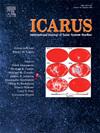利用THEMIS亮度温度数据量化火星熔岩表面非均质性
IF 2.5
2区 物理与天体物理
Q2 ASTRONOMY & ASTROPHYSICS
引用次数: 0
摘要
任何行星表面的分析和特征在很大程度上依赖于轨道数据。火星表面主要是喷出的火山活动,大多数较年轻的岩石要么太粗糙,要么位于着陆器或漫游者通常无法到达的高度。因此,轨道数据的准确解释对于了解地球最年轻的岩浆条件以及随后的陨石坑和风成史至关重要。然而,表面过程的累积效应,如跨越数百万年的尘埃沉积,通常会掩盖可观察到的特征,给数据分析带来挑战。这项研究的重点是从Arsia Mons到Daedalia Planum的火成岩地形,使用了火星奥德赛航天器特殊任务获得的独特的离最低点热红外(TIR)数据集。先前对该地区的研究表明,存在成分变化,但灰尘覆盖使结论性结果不可能。本研究提出了一种新的方法,结合KRC热模型、定量热惯性数据和离轴TIR观测来预测表面温度和量化亚米尺度表面粗糙度。在此过程中,我们揭示了熔岩流粗糙度的变化与相对流动年龄、流动动力学和尘埃优先覆盖有关。将这些数据与较早的、指向最低点的THEMIS发射率数据进行比较,以量化由表面粗糙度引起的等温性。这些结果强调了以新方法获取和处理现有轨道数据的重要性,以检索有关火星火山学和作用于这些表面的持续动力学的新信息。本文章由计算机程序翻译,如有差异,请以英文原文为准。
Quantifying lava surface heterogeneity on Mars using THEMIS brightness temperature data
The analysis and characterization of any planetary surface relies heavily on orbital data. The Martian surface is dominated by extrusive volcanism with most of the younger rocks being either too rough or at altitudes that are commonly inaccessible to landers or rovers. Therefore, the accurate interpretation of orbital data is critical to understanding the planet's youngest magmatic conditions and subsequent cratering and eolian history. However, the cumulative effects of surface processes such as dust deposition spanning millions of years typically obscures observable features, posing challenges for data analysis. This study focuses on the igneous terrains from Arsia Mons and into Daedalia Planum using a unique off-nadir thermal infrared (TIR) dataset acquired through special tasking of the Mars Odyssey spacecraft. Prior studies of this region indicated compositional variations were present, yet the dust cover made conclusive results impossible. This study introduces a novel methodology that combines the KRC thermal model, quantitative thermal inertia data, and the off-axis TIR observations to predict surface temperature and quantify submeter-scale surface roughness. In doing so, we reveal changes in lava flow roughness that can be correlated to relative flow ages, flow dynamics, and preferential mantling of dust. These data are compared to older, nadir pointing, THEMIS emissivity data to quantify the anisothermality caused by surface roughness. The results underscore the significance of existing orbital data acquired and processed in novel ways to retrieve new information about Martian volcanology and the ongoing dynamics acting on these surfaces.
求助全文
通过发布文献求助,成功后即可免费获取论文全文。
去求助
来源期刊

Icarus
地学天文-天文与天体物理
CiteScore
6.30
自引率
18.80%
发文量
356
审稿时长
2-4 weeks
期刊介绍:
Icarus is devoted to the publication of original contributions in the field of Solar System studies. Manuscripts reporting the results of new research - observational, experimental, or theoretical - concerning the astronomy, geology, meteorology, physics, chemistry, biology, and other scientific aspects of our Solar System or extrasolar systems are welcome. The journal generally does not publish papers devoted exclusively to the Sun, the Earth, celestial mechanics, meteoritics, or astrophysics. Icarus does not publish papers that provide "improved" versions of Bode''s law, or other numerical relations, without a sound physical basis. Icarus does not publish meeting announcements or general notices. Reviews, historical papers, and manuscripts describing spacecraft instrumentation may be considered, but only with prior approval of the editor. An entire issue of the journal is occasionally devoted to a single subject, usually arising from a conference on the same topic. The language of publication is English. American or British usage is accepted, but not a mixture of these.
 求助内容:
求助内容: 应助结果提醒方式:
应助结果提醒方式:


